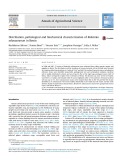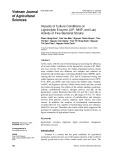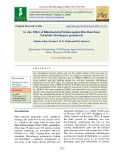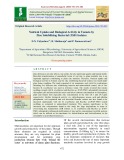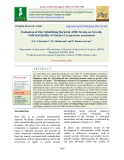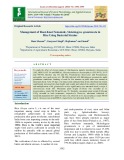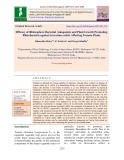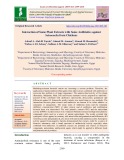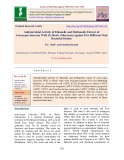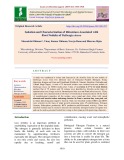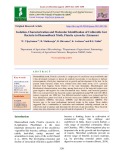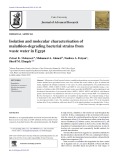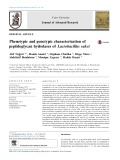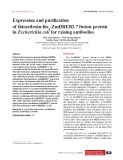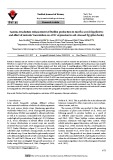
Five bacterial strains
-
The isolated bacterial strains, including the reference strain, were identified using ELISA, pathogenicity test and carbohydrate oxidation. Bacterial wilt is widely distributed in Benin and was found in five of the eight agro-ecological zones (AEZ) of Benin, which correspond to eight of the 12 districts of Benin.
 6p
6p  schindler
schindler
 30-12-2021
30-12-2021
 13
13
 0
0
 Download
Download
-
The imperative demand for antibacterial agents and enzyme inhibitors prompted us to synthesize some new compounds, 6a–6k, bearing multifunctional moieties. The target acetamides were derived from 4-phenyl-5-(1- tosylpiperidin-4-yl)-4H-1,2,4-triazole-3-thiol (3). The structural analysis was carried out using modern spectroscopic techniques including IR, NMR, and EIMS spectral analysis. The antibacterial activity was screened against five bacterial strains including three gram-negative and two gram-positive ones.
 17p
17p  tudichquannguyet
tudichquannguyet
 29-11-2021
29-11-2021
 8
8
 1
1
 Download
Download
-
Escherichia coli C forms more robust biofilms than other laboratory strains. Biofilm formation and cell aggregation under a high shear force depend on temperature and salt concentrations. It is the last of five E. coli strains (C, K12, B, W, Crooks) designated as safe for laboratory purposes whose genome has not been sequenced.
 18p
18p  visilicon2711
visilicon2711
 20-08-2021
20-08-2021
 17
17
 1
1
 Download
Download
-
In this study, with the aim of determining and assessing the influence of several culture conditions on the ligninolytic enzyme (LiP, MnP, and Lac) activity of bacteria, five lignin-degrading bacteria strains were isolated from two different soil samples and cultured on minimum salt medium agar containing alkaline lignin (MSML agar). Among the five isolated strains, DL1 and X3 expressed strong and stable ligninase enzyme activity at various temperature levels (30C, 37C, 50C, and 60C) and were selected for further study.
 10p
10p  chauchaungayxua12
chauchaungayxua12
 09-07-2021
09-07-2021
 26
26
 1
1
 Download
Download
-
Phosphorus plays a major role in growth and development of crops and is often found limiting in almost all types of soils. Phosphorus (P) solubilizing bacteria do the vital processes of mobilization of P from its poorly available sources. In this study, the potency of five bacterial strains (2 strains of Bacillus and 3 strains of Burkholderia) have been evaluated to solubilize P from complexes of Ca-P, Al-P, Fe(II)-P and Fe(III)-P.
 21p
21p  trinhthamhodang6
trinhthamhodang6
 09-07-2020
09-07-2020
 7
7
 2
2
 Download
Download
-
Five rhizospheric bacterial cultures and cell free culture filtrates (CFs) (one strain of Gluconacetobacter diazotrophicus (35-47), two strains of Azotobacter chroococcum viz. AVK-51, HT-54: two strains of Bacillus spp. viz., RKB-91, RKB-65) were evaluated for larval mortality and egg hatching against rice root-knot nematodes (Meloidogyne gramincola) at CCS HAU Hisar.
 7p
7p  nguaconbaynhay6
nguaconbaynhay6
 23-06-2020
23-06-2020
 6
6
 1
1
 Download
Download
-
Zinc deficiency not only affects crop yields, but also nutritional quality and human health. Microbial transformation of unavailable forms of soil zinc to plant available zinc is an important approach contributing to plant zinc nutrition. Therefore, Nutrient uptake and biological activity in Tomato crop by zinc solubilizing bacterial isolates was tested under glass house condition. The study consisted of six treatments, each with five replications, including five different zinc solubilizing bacteria and uninoculated control, out of five bacteria B. aryabhattai was used as reference strain.
 13p
13p  angicungduoc4
angicungduoc4
 26-04-2020
26-04-2020
 11
11
 1
1
 Download
Download
-
An experiment was conducted during the year 2014-15 in Microbiology Laboratory, Division of Soil Science and Agricultural Chemistry, ICAR- IIHR, Hesaraghatta, Bengaluru, India for “Evaluating the zinc solubilizing bacterial strains on growth, yield and quality of Tomato”. The experiment consisted of six treatments with five replications, including five different zinc solubilizing bacteria (Bacillus aryabhattai, Pseudomonas taiwenensis, Bacillus sp.
 10p
10p  kethamoi4
kethamoi4
 18-04-2020
18-04-2020
 9
9
 1
1
 Download
Download
-
To study the effect of eleven strains of rhizobacteria, namely Azotobacter chroococcum (103, MSX-9, HT-54 and BNR-6), Gluconacetobacter diazotrophicus (CO 99-70, 35-47 and 760-50), Bacillus spp (91 and 65), Pseudomonas fluorescens and Pseudomonas maltophila were used on rice (cv. PR-106) infected with Meloidogyne graminicola under greenhouse conditions. Soaking of seed for five minutes in plain water was treated as untreated check.
 4p
4p  cothumenhmong4
cothumenhmong4
 23-03-2020
23-03-2020
 11
11
 0
0
 Download
Download
-
Tomato is affected by a large number of diseases. Among these, collars rot disease of tomato cause by S. rolfsii is a threatening disease in eastern coastal regions of Odisha. Since, this disease is soil borne in nature, it is very difficult to control by chemical fungicides. The native rhizosphere soil of tomato was used for isolation and screening of bacterial antagonists for their efficacy and growth promotion potential. A total of 54 bacterial isolates were isolated from rhizosphere of tomato of which five isolates viz.
 12p
12p  trinhthamhodang3
trinhthamhodang3
 22-02-2020
22-02-2020
 26
26
 1
1
 Download
Download
-
The aim of the study was to isolate and identify the salt tolerant growth promoting bacteria from rhizosphere soil of Sesuvium portulacastrum and also from the soils of dye and textile effluent contaminated sites (Andipalayam, Orathupalayam, Mangalam and Palayakottai villages of Tirupur District, Tamil Nadu) to remediate the salt contaminated soil. On total twenty five strains were selected based on the distinct morphological characters on R2A agar medium supplemented with 3 % NaCl.
 12p
12p  quenchua2
quenchua2
 15-12-2019
15-12-2019
 19
19
 0
0
 Download
Download
-
Multidrug-resistant bacterial strains are becoming a serious problem. Therefore, the application of natural antimicrobial agents from plant extracts combined with antibiotics to overcome this problem is of major importance. The antimicrobial activity of five plants (Rosemary, Marjoram, Mint, Dill and Neem) methanol extract prepared by ultrasonicassisted (UAE) combined with antibiotics (amoxicillin, doxycycline, gentamicin and difloxacin) against 41 Salmonella poultry isolates was tested using in vitro methods.
 12p
12p  kethamoi2
kethamoi2
 14-12-2019
14-12-2019
 20
20
 0
0
 Download
Download
-
Antimicrobial activity of ethanolic and methanolic extract of Artocarpus lakoocha Wall. ex Roxb. bark were evaluated against five oral inhabiting bacteria i.e., Escherichia coli (ATCC 8739), Streptococcus mutans (ATCC 25175), Streptococcus sanguinis (ATCC 10556), Porphyromonas gingivalis (ATCC 33277) and Fusobacterium nucleatum (ATCC 25586) at different concentration by using agar well diffusion method. The test extract was found to be bacteriostatic in action, thus can be used as a source of antibiotic substances for drug development and in the control of these bacterial infections.
 5p
5p  kequaidan2
kequaidan2
 13-12-2019
13-12-2019
 15
15
 0
0
 Download
Download
-
A study was conducted to isolate and characterize the rhizobia from the root nodule of Dalbergia sissoo from five different sites of Himachal Pradesh (Bilaspur, Solan, Hamirpur, Kangra and Una) and Uttrakhand (Rishikesh, Nainital, Haridwar, Dehradun and Udham Singh Nagar). A total of 79 bacterial isolates were isolated from root nodule of Dalbergia sissoo on YEMA media after 3 days of incubation at 37˚C by serial dilution method.
 9p
9p  kequaidan2
kequaidan2
 13-12-2019
13-12-2019
 21
21
 0
0
 Download
Download
-
Diamondback moth, Plutella xylostella is a major pest of cruciferous crops worldwide and it has developed resistance to almost all synthetic insecticides. It was known to harbour microorganisms which play important role in growth and development of the host. In the present study bacterial strains were isolated from third instar larvae of P. xylostella collected from Sugatur, Kolar District of the state Karnataka. Morphological and Biochemical characterization were done, among them most of the bacterial isolates were gram negative and negative for some biochemical tests.
 8p
8p  cothumenhmong1
cothumenhmong1
 11-12-2019
11-12-2019
 20
20
 0
0
 Download
Download
-
Efficiencies of local bacterial isolates in malathion degradation were investigated. Five bacterial isolates obtained from agricultural waste water were selected due to their ability to grow in minimal salt media, supplied with 250 ppm malathion as sole source of carbon and phosphorus. The purified bacterial isolates (MOS-1, MOS-2, MOS-3, MOS-4 and MOS-5) were characterised and identified using a combination of cellular profile (SDS-PAGE), genetic make up profile (RAPD-PCR), and morphological and biochemical characteristics.
 5p
5p  kethamoi1
kethamoi1
 20-11-2019
20-11-2019
 12
12
 0
0
 Download
Download
-
Lactobacillus sakei, a lactic acid bacterium naturally found in fresh meat and sea products, is considered to be one of the most important bacterial species involved in meat fermentation and bio-preservation. Several enzymes of Lb. sakei species contributing to microbial safeguarding and organoleptic properties of fermented-meat were studied. However, the specific autolytic mechanisms and associated enzymes involved in Lb. sakei are not well understood. The autolytic phenotype of 22 Lb.
 9p
9p  kequaidan1
kequaidan1
 16-11-2019
16-11-2019
 16
16
 1
1
 Download
Download
-
To isolate and characterise free nitrogen-fixing bacteria, we collected randomly soil samples from different areas of Ha Noi. Nitrogen-fixing bacteria were isolated using Burk’s medium without nitrogen mineral supplement. The ammonia (NH4 + ) synthesis of these bacterial strains after biomass production was determined by means of Nessler reagent. Based on the results of isolation, we observed and evaluated colony and cellular morphology, pigment production, and metabolic activities of twenty-five isolates. Among the isolated bacteria, two bacterial strains (6.2 and 8.
 7p
7p  caygaocaolon1
caygaocaolon1
 13-11-2019
13-11-2019
 37
37
 0
0
 Download
Download
-
Dehydration-responsive element-binding (DREB) proteins play a critical role in the plant’s droughttolerance mechanism despite their presence in minor amounts in the cell. In this study, a maize-derived transcription factor protein, ZmDREB2.7, was overexpressed in the Escherichia coli strain Rosetta 1. The interested gene conjugating with the thioredoxin gene (TrxA) and his6 tag in the pET-32a vector encoded a 55.7 kDa fusion protein. The optimum condition for inducing the thioredoxin-his6 -ZmDREB2.7 expression was five hours of induction with 0.05 mM IPTG at 300 C. The Tris-HCl 20 mM pH 8.
 7p
7p  caygaocaolon1
caygaocaolon1
 13-11-2019
13-11-2019
 11
11
 0
0
 Download
Download
-
Gamma rays are known to induce random mutations, which are used to enhance the production of biofilms in bacteria. Therefore, to improve the activity of biofilm formation in wild Bacillus amyloliquefaciens (HM6), this bacterial strain was mutated using five doses of gamma irradiation.
 14p
14p  caplock2711
caplock2711
 21-02-2019
21-02-2019
 18
18
 0
0
 Download
Download
CHỦ ĐỀ BẠN MUỐN TÌM








